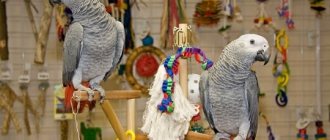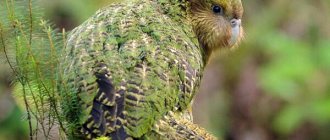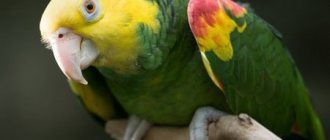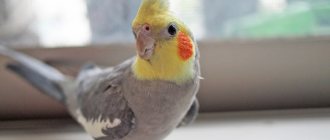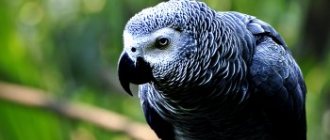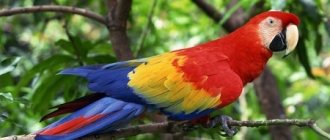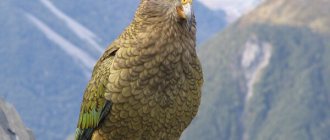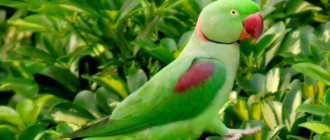The African gray parrot is one of the most intelligent birds in the world. Natural cunning, observation and caution help Grays survive in natural conditions, and also contribute to rapid adaptation in captivity. This parrot, despite its difficult character, easily communicates with humans and learns quickly. The long-lived parrot effortlessly copes with the role of everyone's favorite, but determines only one companion for itself.
This article contains all the most interesting things about the African Gray parrot: appearance, place of residence, intelligence, health and longevity. In addition, the secrets of choosing, training and successfully keeping an “African” at home are revealed.
Habitat and lifestyle
The distribution area of the gray parrot is the African continent, or rather its central and western regions: Guinea, Congo, Gabon, Cameroon, Tanzania. In these places the equatorial forest belt of Africa is located. On the west coast there are mangrove forests where African parrots love to live. In addition to mainland areas, parrots are also attracted to the islands of the Gulf of Guinea.
Grays have a highly developed family instinct; they cannot live alone, so they form flocks of several hundred individuals. When the nesting season arrives, married couples form within the colony. The female sits on the eggs, and the male guards the nest and carries food to the partner.
They roost for the night in the dense crowns of tall trees. There, hiding in the foliage, they spend the hottest part of the day. At dawn, the flock goes to the pond and in search of food. There are plenty of food sources in the forest: these are shrubs and grasses with various seeds, fruit and berry trees, and edible roots. When there is not enough food, birds raid farmland and destroy fields. Because of this, feathered thieves often fall under bullets.
Jaco in the wild
Grays have many enemies among representatives of the animal world: snakes, birds of prey, rodents that steal eggs. A particular threat comes from human poachers who hunt parrots for sale.
This is interesting! Gray parrots are known for their caution, they are able to hide from predators and signal danger to each other. In order not to attract attention to itself, the bird quickly and deftly moves along the trunk, clinging to the branches with its beak.
Population and species status
As a result of a recent analysis of the state of the gray parrot population, it was found that the birds found themselves in an unenviable position. Every year, people remove more than 20 percent of parrots from the wild, catching parrots for sale. Moreover, the total number of gray parrots is decreasing as a result of human destruction of their natural habitat, as a result of the negative impact of pesticides on the natural environment, as well as as a result of the extermination of these birds by local residents. Traps used to catch birds for their further sale are today the main tool that negatively affects the reduction in the number of these birds.
It is important to know! At the beginning of the 19th century, the total number of gray parrots was estimated at 13 million individuals, although this information is not reliable. This is due to the fact that research is very difficult to conduct due to the fact that these birds often live in isolated areas with an unstable political situation.
Gray parrots are endemic to the primary and secondary forests of West and Central Africa and are found nowhere else. The life activity of these birds directly depends on the presence of huge old trees with hollows where the Grays build their nests. As a result of studies conducted by specialists in countries such as Guinea and Guinea-Bissau, it was possible to establish a strict connection between the number of these parrots and the presence of primary forest. If such forests are reduced, then the number of these birds is reduced.
It should be noted that in our time, gray parrots are considered super-selling birds, which is registered in CITES. As numbers continue to decline and illegal trade continues, CITES included the species in Appendix VI of Existing Trade in 2004. This application regulates quotas for some countries and also regulates the species management process.
Description and features
The African parrot is different from most members of the parrot family. This is a gray bird, rather inconspicuous in appearance. She does not have bright multi-colored plumage, but her color is remarkable in its own way.
What does a gray parrot look like? Let's draw his verbal portrait:
- The body is covered with gray feathers of different shades: from mother-of-pearl to graphite.
- On the head and neck the tips of the feathers are light with an interesting scaly pattern.
- From the chest to the undertail and thighs, the feathers gradually become lighter. The skin of the fingers is rough, formed by ashy-colored scales.
- The outer surface of the wings is the darkest in relation to the total mass of the plumage. The flight feathers are almost black.
- The short, spade-shaped tail is red or brown, depending on the type of bird.
- On the head there is a white facial mask - around the eyes and on the bridge of the nose there are unfeathered areas in the form of “glasses”.
When describing a gray parrot, one cannot fail to mention two striking details: a powerful black beak with an elongated tip and expressive eyes. The chicks' eyes are black and shiny, but over time the iris becomes yellow. In particular, by this sign you can recognize the age of the parrot.
The Gray is strong and stocky, its body length is 30-40 cm, its weight is approximately 500-600 g, its wingspan is 60-65 cm. Females are slightly smaller, but their color is the same as that of males.
Reproduction in nature and captivity
Nests are made in tree hollows. During the nesting season, the male performs a courtship dance. It slightly ruffles its plumage, lowers its wings and dances around the female. At the same time, he makes sounds similar to the whining of puppies or grunting. The female makes the same sounds and takes the pose of a chick begging for food. The male either feeds her or imitates feeding. The male and female behave in this way several times a day. The mating dance lasts approximately 5-10 minutes. After some time, the female begins to lay eggs. There are 3-4 white eggs in the clutch. At 8-12 days the female completes the clutch. Incubation lasts 30 days; after the chicks hatch, the female does not leave the nest in the first days, and the male feeds and protects her. At the age of just over two months, the chicks fly out of the nest, but still need the help of their parents for some time. In Western countries, Grays are easily bred in captivity (including with the help of incubators), so there is little demand for illegal birds there. In Russia, the situation is worse; due to the virtual absence of competent breeders, lack of information among people and a fairly low price, the demand for wild Grays is quite high.
Types of gray parrot
African gray parrots have a memorable appearance. They cannot be confused with other birds. The following types of Grays are known, distinguished on the basis of external characteristics:
- Redtail. Ash plumage, black beak, red tail. Red-tailed gray
- Brown-tailed. The body size is smaller and the feathers are darker than those of the redtail. The mandible is brownish-beige on top, the tip and mandible are black. The tail is chestnut.
Brown-tailed gray - Jaco Princess of Ghana (royal). The largest of the three subspecies. Distinguished by red speckles on gray feathers. In some individuals, red color predominates, and gray feathers grow in a chaotic manner.
Royal Gray
Of course, the royal variety of gray parrots is the most original and attractive among the gray parrots, but also more rare. In nurseries, individuals with unique colors are bred: albino chicks and multi-colored parrots are produced. Such birds cost much more than gray ones.
The key to fast and high-quality training
When solving the question of how to teach a parrot to talk in practice, you must adhere to some rules, otherwise the result of the process will be negative.
Regular classes
To teach your pet to speak, you need to work with it systematically. Lessons should take place every day and take approximately 15-25 minutes. Once a week you can conduct a kind of control session lasting 35-45 minutes.
Insulation
Experts recommend isolating a parrot whose owner wants to teach him to speak. Neighbors in the cage make it difficult to concentrate and distract the bird’s attention during lessons. Some experts recommend removing unnecessary toys and accessories from the cage.
Nothing should distract the pet's attention from activities, otherwise achieving the goal is not guaranteed.
No stress
The atmosphere during classes should be calm and friendly. The bird should not be afraid of anything, otherwise a good result may not be expected. Therefore, you can only train parrots that have already adapted to their living conditions.
It is worth mentioning separately:
- Inadmissibility of punishment. Their use will have the completely opposite effect.
- The need to conduct a lesson only in a good mood. Birds feel the emotions of their owners. A person’s manifestation of irritability will not go unnoticed. Psychological contact with a feathered pupil can be hopelessly damaged.
Motivation
Motivation is extremely important in the learning process. You can achieve a positive attitude in your parrot and a desire to learn new words by giving him a treat every time after successfully completing a task.
Patience
Patience and work will grind everything down, says a Russian folk proverb. This fully applies to the training of parrots. The person handling the bird should not try to force things too much. He should not abandon the process after the pet’s first failures. All difficulties will be overcome after persistent and systematic work.
Gray's intelligence
Like most parrots, Grays have the ability to “talk.” However, in comparison with other species, it wins by a huge advantage. An African can not only remember and clearly reproduce several hundred words and phrases, but also use them appropriately. If other parrots only repeat (imitate) what they hear, then the gray parrot knows how to conduct a dialogue with a person and is open to new knowledge.
Did you know? In America, a domesticated Gray named Baby assisted the police in catching criminals - he remembered the names of the robbers who entered the apartment and named them to law enforcement officers.
A smart bird needs constant training. You can endlessly be amazed at the intellectual abilities and physical capabilities of the Gray, especially if you raise your feathered pet correctly. This is not difficult to do, given that a gifted “student” responds with interest to educational games and copes with the assigned tasks.
The gray parrot is not a gift bird at all. The Gray's character has such traits as irritability, rancor, and jealousy. He tries to dominate, but, having received a rebuff, does not rest on this. He chooses a “favorite” in the family and follows him everywhere, participates and helps in all matters.
Where to start teaching Grays to speak?
First of all, you need to love your pupil, always talk to him emotionally, affectionately, being completely enchanted by his unique beauty and sociability. If the only goal is to own a talkative parrot, it is better to refuse the purchase altogether, since very often the owner, who is determined to receive a sensation, suffers a complete fiasco. A pet needs love and trust, only then does it become responsive. And you need to start your lessons with short, most ordinary words.
Where to start to teach a Gray to speak
How many years does a Gray live?
The lifespan of grays in nature is difficult to track, since observations of flocking birds that roam over large territories are difficult. Naturalists only guess how long a gray parrot lives in its natural environment - this period does not exceed one and a half decades. Individuals, under favorable conditions, can live much longer. But domestic parrots are able to live to a ripe old age, which occurs at about 40-50 years of age. The scientific journal International Zoo Yearbook reports reliable data on Gray Coat, who died at the age of 49.7 years.
Reason and onomatopoeia
Grays are considered the most talented parrots, capable of onomatopoeia. On average, a bird can remember more than 100 turns of speech. Extensive research with African Grays named Alex by Irene Pepperberg, PhD, has shown that these birds can associate words in human language with the objects they represent, and are also able to perceive the concepts of shape, color, serial number and even the concept of zero.
Many grays begin to learn to speak by the age of two or three years; brown-tailed grays begin to learn a little earlier than their red-tailed counterparts. Wild Grays very often make different sounds - they whistle, squawk, squeal, loudly click their beaks, etc. At home, these sounds may seem annoying to many, but this is part of their nature and anyone who wants to have a Gray will have to come to terms with it. Grays often strive to imitate the sounds made by consumer electronics - telephones, intercoms or alarm clocks. They often repeat the sounds of wild birds living outside.
Keeping at home
Many people dream of a pet like a Gray. In order for a feathered intellectual in captivity to feel good, not get sick and meet the owner’s expectations, it is necessary to provide him with suitable conditions. Keeping a large, loud-voiced bird at home is quite difficult, and this is primarily due to the noise it makes. As for the material base (housing, food, accessories), it is much easier to prepare. However, there are some nuances here too, which we will discuss further.
Arrangement of the cage
You should choose a cage for a Gray parrot especially carefully: this parrot requires space and convenience combined with safety.
- The structure should be created on the basis of a mesh of steel rods 3-5 mm thick. The gray parrot can bite through thinner wires and get injured. The cellular structure of the mesh is convenient because it is convenient for the parrot to climb along the intersecting rods, clinging with its beak.
- Minimum cage dimensions: 50 cm width, 80 cm length, 100 cm height. This is the necessary sanitary standard for one parrot. The more residents there are, the more spacious the room should be for them.
- There are no special requirements for the shape, but it is believed that a rectangular cage is best. The cylindrical one should be abandoned, since in the rounded space the bird will have nowhere to hide.
- It is necessary to properly arrange the inside of the cage: secure wooden perches of different diameters, hang play accessories, install feeders and drinking bowls.
It is not allowed to place the cage on the floor - there are drafts below, and it is also easier for pets (if any) to get to the bird.
Important to remember! No matter how comfortable the cage is, it cannot be done without daily walks. You need to let your pet out for a couple of hours so that it can fly and frolic.
Diet
How long Grays live at home depends to a large extent on their diet. In nature, they feed on various seeds, fruits, nuts, and succulent herbs. A complete diet for a domestic parrot contains dry cereal mixtures, sprouted grains, vegetables, fruits and herbs. During special periods of life (molting, breeding season), birds need mineral and vitamin supplements.
Among commercially produced gray food, mixtures are suitable for large parrots. Every day the bird should eat about 3 tablespoons of dry assortment. If you feed your parrot a large amount of food, it may become overweight, especially if it leads a sedentary lifestyle.
Parrots love soft grains collected at the milk stage. It is difficult to provide such food at home, but there is an alternative option - a germination kit. Dry grain is moistened and kept warm for 2-3 days, obtaining soft sprouts that are tasty and healthy for Grays.
Care and hygiene
Proper care of a parrot in terms of hygiene means regularly cleaning and disinfecting the cage and perches, washing feeders and drinking bowls, and organizing bathing for the parrot himself.
Grays are generally not afraid of water. On the contrary, they look for every opportunity to swim. Hearing the sound of water flowing in the bathroom, the gray parrot flies there and joyfully climbs under the stream. Splashes with pleasure in a basin, bathing suit, or sink. Bathing helps poultry to normalize body temperature, relieve itching, and freshen up. In addition, water procedures for Grays are one of the elements of the game.
Parrots independently monitor the cleanliness of their feathers - they lubricate them, pluck out broken ones, arrange them side by side, and stir up the fluffs. The beak is also the subject of attention - the gray gray grinds off the horny tissue, running along the perch first with one side of the beak, then with the other. The claws shorten involuntarily as the bird moves or when the parrot grips the perch with its fingers.
Important: excessively long claws make it difficult for the parrot to move and cling to the fabric. They need to be trimmed in time, otherwise injuries are inevitable.
Diseases and their prevention
Diseases of parrots are infectious, non-infectious and parasitic. In gray parrots living in houses, infectious diseases are rare. Birds purchased from dubious places pose a danger. After purchase, the Gray must sit in a cage in quarantine for 2-3 weeks. At this time, he should not be allowed to go for a walk or be allowed to come into contact with other pets and birds. If the quarantine is followed according to all the rules, the risk of infection with helminths, ticks and viral infections is minimized.
Parrots are social birds that, with a lack of attention, become depressed and sometimes begin to pluck feathers. Grays have a much more pronounced tendency to self-pluck than other parrots. This is a psychological disease, sometimes incurable. Occurs only in birds living in captivity, especially after suffering stress.
Jaco after self-plucking
Other diseases are quite common in Grays, such as indigestion, inflammation of joints and mucous membranes, and vitamin deficiency. They are relatively easy to deal with, but it is better to avoid them.
So that there is no reason to wonder how long a gray parrot lives, you need to care for it:
- monitor the indoor microclimate;
- ensure good sanitary condition of the cage and accessories;
- buy high-quality, fresh food.
Preventive measures include regular visits to the veterinarian, as well as independent daily examination of the pet.
Causes of death
In the wild, gray parrots have many enemies, but when kept indoors, long-lived birds seem to have nothing to fear. Nevertheless, the domestic Gray is not immune from premature death. The length of time a Gray Gray lives with its owner is influenced by the owner’s forethought or negligence. Most often, tame parrots die due to oversight:
- from electric shock through a broken electrical wire;
- having received an injury incompatible with life (being crushed by a door, unnoticed and suffocated in a heap of things);
- freezing near an open window in winter;
- from attacks by domestic animals.
Unobvious causes of death are associated with the gradual accumulation of toxic substances in the body. Aerosols, essential oils, tobacco smoke, and fumes of chemicals contained in household items and liquids are toxic to parrots. One of the common causes of death of parrots is poisoning with bad food.
Jaco, with his intelligence, level of development and tendency to become attached to people, becomes a member of the family. The loss of a pet is not easy to come to terms with, which is why it is so important to monitor its health and never leave it unattended outside its cage.
Techniques for teaching simple words
There are numerous techniques, they are accessible and very effective. However, without an emotional component, a teacher will not achieve success. Even the simplest words in the first lessons should be pronounced with a gentle intonation: “Gosh is good”, “Hello, Gosha!”, “Kesha, bye!”, “Dasha, how are you?”
A parrot can have absolutely any name, although it is believed that the presence of a hissing sound in it accompanies success in mastering speech. And you should always talk to your pet, from the very first minute, constantly calling him by name, then the transition to the lesson itself will be made smoothly.
When communicating with a bird, tactile contact is desirable. I always stroke my Gray when we talk, no matter where he is: in a cage on a perch, or on my shoulder. Even when doing ordinary household chores, it is better to comment on them out loud: “Gosha needs to eat!” (if I pour food), “It’s time to wash!” (when the bath is ready), “Now it’s clean!” (during cleaning).
Parrot training technique forgive words
I didn’t even think that the parrot listened to and remembered everything, and I was very surprised by these “incidental” phrases a year and a half later. The owner needs to be patient and not stop practicing; his efforts will definitely be rewarded over time. Most often, the first word of a gray parrot is its name. Our Gosha said “eat.” And it was great joy!
How to teach a gray parrot to speak
After a successful adaptation period, you can begin training. The parrot is taught to speak, starting with short words containing the sounds “a”, “o”, “r”, “ch”, “sh”. Usually the first word that a bird remembers is its nickname. For lessons, you need to choose a time when the Gray is already slightly hungry, but it is not yet time to feed. Success will have to be rewarded with treats, so the bird’s appetite will play into your hands.
The word is pronounced loudly and clearly several times in a row, then another. This technique promotes better memory. The lesson lasts no more than 15 minutes, otherwise the student will get tired and lose interest, and will stop perceiving what he hears. The regularity of lessons is very important - they must be repeated daily, and in the breaks between them the material is consolidated at the associative level.
The method of teaching sound pronunciation is the same for all parrots, but in the case of grays, the result comes much earlier. Such a capable “student” quickly picks up new words, memorizes them, trains independently and is delighted with himself.
How to properly reward a bird for success?
The main thing is to praise the parrot, always do it affectionately and with soul, because he will sense the slightest pretense or insincerity. Even if there is no audible result yet, it is clear that the bird is listening, it is attentive, it is necessary to encourage it even more emotionally and actively with words. And be sure to give some kind of treat, for example, your favorite seeds.
However, if the student does not have confidence in the teacher, nothing good will come of joint activities. You need to become a companion, a best friend, only then mutual understanding arises. A parrot copies all the actions of a person it likes, and this includes not only behavior, but also spoken words.
Jaco (savage) 2nd day since he started talking)) Kuuurochka, oh))
You must not violate your pet's personal area. Sudden movements can frighten him, or at least alert him. Don't even say words of encouragement too loudly. Long classes also do not make sense. Five or ten minutes is enough. And the owner himself will probably get tired of repeating the same word.
